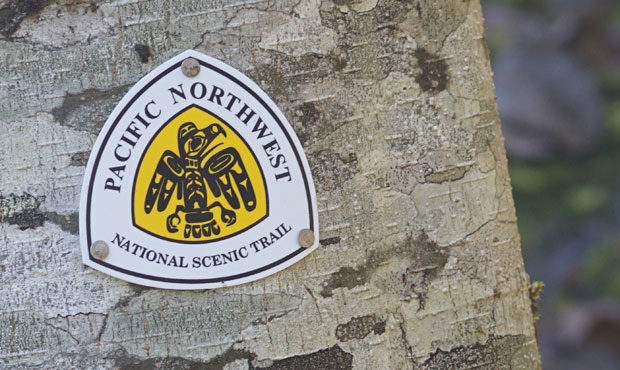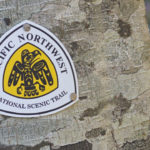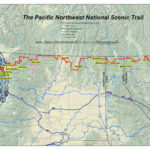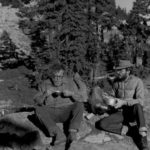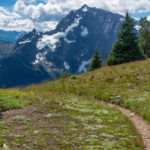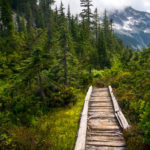All Over The Map: 1,200 miles of history on the Pacific Northwest National Scenic Trail
Aug 27, 2021, 8:02 AM | Updated: Aug 31, 2021, 7:17 am
You’ve probably heard of the Appalachian Trail or the Pacific Crest Trail – those very long north-to-south trails that attract thousands of hikers each year – and, in the case of the Pacific Crest Trail, that Reese Witherspoon so charmingly explored in the film Wild a few years ago.
Those two famous trails, along with nine others, are part of something called the National Scenic Trail System, comprising a total of 11 long-distance pathways in various regions of the United States.
Among those nine others is one you might not have heard of yet called the “Pacific Northwest National Scenic Trail.” It’s also known as the Pacific Northwest Trail – or the PNT – for short.
The PNT stretches for 1,200 miles from the Continental Divide in Montana, across the Idaho panhandle, and along the northern portion of Washington and then the Olympic Peninsula – crossing Puget Sound requires hiking onto Whidbey Island and taking the ferry from Coupeville to Port Townsend. The official terminus is at Cape Alava, the westernmost point in the continental United States on the Washington coast.
The idea for a network of cross-country paths like this can be traced to the Appalachian Trail – which was first conceived in 1921 by a planner named Benton Mackaye, and which was then gradually assembled from existing regional trails throughout the 1920s and 1930s.
The history of the Pacific Northwest Trail only goes back to the 1960s, and a federal study and report called “Trails for America” – which was inspired, at least in part, by the Appalachian Trail – that led Congress to pass the National Trails System Act of 1968. That federal act recognized those earlier trails and called for creation of more.
Pacific Northwest hiking guidebook author and outdoorsman Harvey Manning gets some of the credit for the Pacific Northwest Trail – specifically, for inspiring another local outdoors enthusiast named Ron Strickland who was in his 20s at the time.
“[Manning] was up in the North Cascades and he looked out west, and he said, ‘Tomorrow the Pacific Ocean,’” said Jeff Kish, executive director of the nonprofit Pacific Northwest Trail Association, a group that advocates for and helps manage the PNT. “And of course, it was a joke, because you can’t hike that far in a day, but the idea of being able to hike from the mountains all the way to the ocean was an inspiration for Ron Strickland.”
That was in 1970. Ron Strickland’s idea and the basic route he mapped out attracted support from the backpacking community, and local enthusiasts Janet Garner and Rex Bakel wrote and published a seminal feature story in Backpacker magazine that further fueled enthusiasm for the PNT.
Strickland and others launched the Pacific Northwest Trail Association in 1977 and began working with volunteers and federal and state land managers to formally assemble segments of trail into a cohesive route. It took until 2009 for the Pacific Northwest Trail to be officially designated a National Scenic Trail – which is part of the reason the PNT remains relatively unknown compared to the Pacific Crest Trail.
Kish and the PNTA still advocate for the Pacific Northwest National Scenic Trail, and the organization coordinates access agreements with private landowners and with the various public agencies whose lands the trail crosses – and offers maps, guidebooks, and other online resources for PNT hikers.
Like other trails of this scope and scale, the route of the Pacific Northwest Trail isn’t a single, separate trail created entirely from scratch. It’s more like a “corridor” – it encompasses existing trails on state lands, and in National Parks and National Forests, and over some private land as well.
The PNT also currently includes several stretches along roadways. Kish says it will take a few more decades to migrate all those roadway stretches into more natural areas, which is not an uncommon timeframe in the world of trail development. For example, the Appalachian Trail may be 100 years old, but the last piece of private land along the route was secured just seven years ago. These trails are long-term labors of love that call to mind the old saying about planting trees whose shade you won’t live long enough to enjoy.
The PNT has a handsome logo and tasteful signage based on National Scenic Trail System standards, both of which are becoming more visible along the route of the trail – even to motorists driving past.
“There are some places where a PNT trailhead is visible from the highway,” Kish said. “You can see [signage] when you’re driving by along Highway 20 around the Kettle Crest area outside of Republic, Washington. You can definitely see some outside of Oroville, Washington, … and you can see some when you’re driving across the bridge at Deception Pass State Park, … there are big markers there.”
Because it is still relatively new, Kish says the Pacific Northwest Trail also doesn’t yet see the huge numbers of what are called “thru-hikers” – people who travel the entire route. It’s estimated that somewhere around 65 to 70 people hike make the full Pacific Northwest National Scenic Trail trek each year, while the number who hike the entire Appalachian Trail or Pacific Crest Trail is closer to 1,000.
Becky Blanchard is the trail administrator for the Pacific Northwest National Scenic Trail. She works for the USDA Forest Service out of the agency’s Pacific Northwest Regional Office in Portland.
Blanchard says that you don’t have to hike the whole thing – which could take as long as a few months – to experience the PNT, because there are plenty of opportunities to enjoy shorter stretches for day hikes or overnight backpacking trips.
“There are a lot of opportunities for people to get out and take short trips,” Blanchard told KIRO Radio, “even if they’re not ready to hike the whole trail end to end.”
“I think it goes through some of the most amazing and diverse landscapes in our region and provides some of the best scenic experiences that hikers can have anywhere in the country,” Blanchard said.
The Forest Service is the federal agency designated as the administrator of the PNT, though the route does cross many jurisdictions. Blanchard and volunteer advisors will be working on a draft comprehensive plan, and she says that there will be opportunities for public input before that plan is finalized sometime in 2023. Completing the trail – really completing it – will stretch out well into the 21st century.
“I wish I could give a more specific timeframe than ‘over the decades,’” Blanchard said. “But we’ve seen from the experience of other longer established trails like the Pacific Crest Trail or the Appalachian Trail that these efforts to complete a trail really, in many ways, are still works in progress, even for those trails that were designated in 1968.”
One very cool fact about the much more established and much better known Pacific Crest Trail, which goes from Canada to Mexico through Washington, Oregon, and California, is that the idea for it came in 1926 from an instructor at what’s now Western Washington University named Catherine Montgomery. Montgomery had read about the Appalachian Trail in 1924, and in 1926 suggested a similar trail for the Pacific Coast to author and mountaineer – and textbook salesman who she happened to meet with on school business – Joseph Hazzard, who shared the idea far and wide, and who credited Montgomery in print in 1946.
Montgomery died in 1957 and was never properly feted for her idea while she was alive, though she was recognized posthumously by the mountaineering community and the Pacific Crest Trail Association.
There are currently no plans to produce a Hollywood movie about Catherine Montgomery or about the Pacific Northwest National Scenic Trail, but if there were, Reese Witherspoon would be a shoe-in for the lead role in either one.
You can hear Feliks every Wednesday and Friday morning on Seattle’s Morning News, read more from him here, and subscribe to The Resident Historian Podcast here. If you have a story idea, please email Feliks here.

